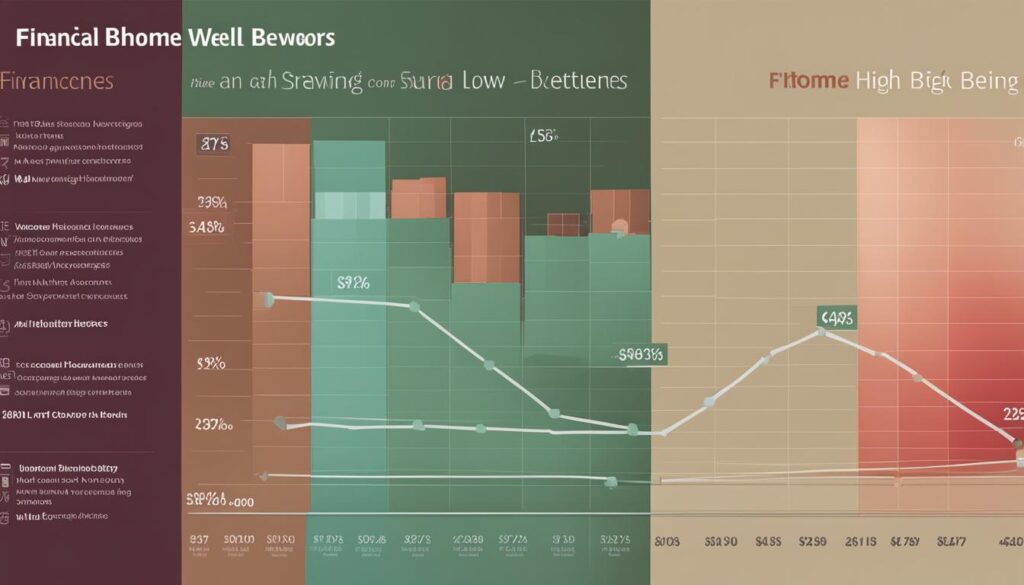The financial divide between high-income and low-income groups has become a topic of widespread concern in the United States. As perceptions of economic inequality persist, there is a growing belief that the rich are getting richer while the poor are becoming poorer. This sentiment is echoed by individuals in the lowest income bracket, who express dissatisfaction with their financial situations, marking a 25-year low in financial satisfaction. The gap in living standards between the middle class and the poor has also widened over the past decade, further deepening the sense of inequality. Similarly, the perceived gap between the middle class and the rich is believed to have expanded.
Notably, opinions about wealth, poverty, and inequality are more influenced by partisan affiliation rather than educational or income differences. However, individuals with lower education and incomes are more likely to perceive success as being determined by factors beyond an individual’s control. Interestingly, the majority of Americans acknowledge that the poor work but struggle to earn sufficient income.
Key Takeaways:
- There is a growing perception of widening economic disparities between the high-income and low-income groups.
- Financial satisfaction among individuals in the lowest income bracket is at a 25-year low.
- The gap in living standards between the middle class and the poor has widened over the past decade.
- Partisan affiliation strongly influences opinions about wealth, poverty, and inequality.
- Individuals with lower education and incomes believe that success is determined by external factors.
Income Disparities and Perceptions of Economic Inequality
Perceptions of income disparities and economic inequality play a significant role in shaping public opinion and understanding societal dynamics. Over the past decade, there has been a widening gap in living standards between the middle class and the poor, according to popular perception.
The belief that the economic gap between the middle class and the poor has increased is shared among the majority of Americans, encompassing various demographic and political groups since the 1980s. This perception of a larger disparity reflects concerns about economic inequality and its impact on societal well-being.
Furthermore, most Americans also perceive a wider gap in living standards between the middle class and the rich compared to a decade ago. This perception suggests a growing awareness of income disparities and the concentration of wealth among the affluent.
While there are modest partisan differences in perceptions of income disparities, with Democrats tending to acknowledge wider gaps in living standards, it is noteworthy that the values and aspirations of the poor and the middle class are perceived to have become more similar in recent years. This shift in perception may indicate a collective recognition of shared economic challenges and common aspirations for upward mobility.
The Perception of Income Disparities
To gain a deeper understanding of how income disparities are perceived, it is essential to examine the factors shaping public perception. Sources such as media coverage, personal experiences, and socioeconomic contexts influence the way individuals perceive economic inequality and its implications.
“Perceptions of income disparities are shaped by a complex interplay of factors, including media narratives, personal experiences, and social environments. These perceptions not only reflect people’s understanding of socioeconomic inequality but also impact the way they perceive the fairness of economic systems and their place within society.”
It is crucial to analyze how income disparities are perceived and understood in order to address societal concerns and promote a more equitable distribution of resources. Through a nuanced understanding of these perceptions, policymakers and stakeholders can work towards implementing effective strategies to reduce economic inequality and improve living standards for all.
Public Perception of Income Disparities
| Perception of Income Disparities | Percentage |
|---|---|
| Widened gap in living standards between the middle class and poor | 73% |
| Wider gap in living standards between the middle class and rich compared to 10 years ago | 67% |
| Values and aspirations of the poor and middle class have become more similar in recent years | 58% |
Admiration of Success and Views on Poverty
In examining the public’s perception of success and poverty, it becomes evident that while there is a widespread admiration for individuals who achieve success through hard work, regardless of their wealth, the same level of admiration does not extend to those who are simply wealthy without any mention of their efforts. This highlights the importance placed on personal effort and determination in achieving success.
Interestingly, a significant portion of the population believes that individuals are poor primarily due to circumstances beyond their control, rather than a lack of effort on their part. This perspective reflects a nuanced understanding that poverty is not solely a result of personal shortcomings, but often influenced by external factors and systemic issues.
Furthermore, the majority of people acknowledge that individuals living in poverty do work but are unable to earn enough money to improve their circumstances. This challenges the misconception that poverty is solely a result of laziness or a lack of work ethic.
It is important to note that opinions on the causes of poverty vary among different racial and educational groups. For instance, whites are evenly divided between attributing poverty to circumstances beyond one’s control and a lack of effort. These differing viewpoints highlight the complex nature of poverty and the need for comprehensive approaches that consider various societal factors.
“Success is not the key to happiness. Happiness is the key to success. If you love what you are doing, you will be successful.” – Albert Schweitzer
Through an examination of these views on success and poverty, it becomes clear that admiration for hard work and recognition of external factors influencing poverty are prevalent in society. These insights provide a deeper understanding of the complexities surrounding economic inequality and can inform discussions around policies and initiatives aimed at reducing poverty.
The Role of Education in Shaping Views on Poverty
It is worth delving into the impact of education on individuals’ perspectives on poverty. Education serves as a critical factor in shaping one’s understanding of the causes and solutions to poverty. Research has shown that individuals with higher levels of education are more likely to attribute poverty to structural factors rather than personal choices.
Moreover, education equips individuals with the knowledge and critical thinking skills needed to challenge stereotypes and misconceptions about poverty. It fosters empathy and a broader perspective that acknowledges the structural barriers faced by marginalized communities.
“Education is the most powerful weapon which you can use to change the world.” – Nelson Mandela
By promoting education and fostering nuanced discussions about poverty, we can work towards a more empathetic and inclusive society that seeks to address the root causes of economic inequality.
| Views on Poverty | Racial Group | Educational Group |
|---|---|---|
| Poverty attributed to circumstances beyond control | White | Evenly divided |
| Poverty attributed to lack of effort | White | Evenly divided |
| Poverty attributed to circumstances beyond control | Non-white | Majority |
| Poverty attributed to lack of effort | Non-white | Minority |
Table: Views on Poverty by Racial and Educational Groups
Financial Well-being and Financial Education
Financial literacy is an essential skill in today’s complex financial world. However, the United States faces a significant challenge as financial literacy levels remain low, especially among individuals with lower education and incomes. Lack of financial education can have detrimental effects on individuals’ financial well-being and behavior.
Fortunately, research has shown that financial education has a positive impact on financial literacy and overall financial well-being. Studies have demonstrated that individuals who receive financial education during high school, college, or through employers tend to have higher financial literacy scores.
Financial education is particularly crucial for individuals with lower education and income levels. These individuals are more likely to lack financial literacy skills, leaving them vulnerable to financial instability and poor decision making.
By equipping individuals with the knowledge and skills needed to make informed financial decisions, financial education can empower individuals to improve their financial well-being. It can help individuals develop effective money management strategies, enhance their understanding of basic financial concepts, and enable them to navigate the complexities of personal finance confidently.
The Impact of Financial Education
Financial education provides individuals with the necessary tools and knowledge to:
- Manage their income and expenses effectively
- Create and stick to a budget
- Understand different financial products and services
- Make informed decisions about saving, investing, and borrowing
- Protect themselves from fraud and scams
By empowering individuals with these skills, financial education helps improve financial well-being, reduces financial stress, and creates a pathway to long-term financial success.
Addressing the Financial Literacy Gap
To bridge the financial literacy gap in the United States, proactive measures are needed to ensure that individuals of all backgrounds have access to quality financial education. This includes:
- Incorporating financial education into school curricula at all levels
- Providing financial literacy programs in collaboration with community organizations, financial institutions, and employers
- Promoting public awareness about the importance of financial education
- Supporting research and evaluation of financial education initiatives to identify best practices
By prioritizing financial education and equipping individuals with the necessary knowledge and skills, we can empower individuals to make informed financial decisions and improve their financial well-being.
| Key Benefits of Financial Education | Impact on Financial Well-being |
|---|---|
| Enhanced financial literacy | Improved financial decision making |
| Effective money management | Reduced financial stress |
| Increased awareness of financial products and services | Protection against fraud and scams |
Financial education plays a pivotal role in empowering individuals to take control of their financial future. By investing in financial education initiatives, we can build a more financially literate society and promote greater financial well-being for all.

The Importance of Financial Behavior and Financial Stress
When it comes to achieving financial well-being, financial behavior and financial stress are critical factors to consider. Poor financial behaviors, including difficulty managing debt and low saving rates, can lead to long-term financial problems. On the other hand, financial stress can have a detrimental impact on decision-making and result in negative financial outcomes.
Multiple studies have emphasized the significance of financial behavior, financial literacy, and financial stress in understanding the financial well-being of different groups. For instance, research conducted on the B40 group in Malaysia has shed light on the intricate relationship between financial behavior, financial stress, and overall financial well-being.
Proper money management and wealth management strategies play a vital role in enhancing financial well-being. By actively managing their money and making wise financial decisions, individuals can improve their financial situation and build a stronger foundation for their future.

The Impact of Financial Behavior
Effective money management involves making conscious choices about spending, saving, and investing. By adopting positive financial behaviors, individuals can enhance their financial health and achieve their monetary goals.
Some key financial behaviors include:
- Budgeting: Creating and sticking to a budget helps individuals track their income and expenses, ensuring they live within their means.
- Saving: Developing a habit of saving money regularly helps build an emergency fund and prepares for future financial goals.
- Debt management: Being proactive in managing debt by paying off high-interest debt first and avoiding unnecessary debt can lead to greater financial stability.
- Investing: Making informed investment decisions can potentially grow wealth over time and diversify one’s financial portfolio.
Adopting these positive financial behaviors can contribute to long-term financial well-being.
Understanding Financial Stress
Financial stress can have a significant impact on an individual’s mental, emotional, and physical well-being. It can arise from various sources, such as overwhelming debt, job insecurity, or lack of savings. When experiencing financial stress, individuals may make impulsive financial decisions, further exacerbating their financial difficulties.
Reducing financial stress involves:
- Building an emergency fund: Having a financial safety net can provide peace of mind and help mitigate unexpected expenses.
- Seeking financial support: Consulting with financial professionals or attending financial education programs can offer guidance and support in managing financial challenges.
- Practicing self-care: Engaging in stress-reducing activities, such as exercise, meditation, or spending quality time with loved ones, can alleviate financial stress and promote overall well-being.
By addressing financial stress and seeking proactive solutions, individuals can regain control of their finances and improve their overall quality of life.
| Financial Behavior | Effect |
|---|---|
| Difficulty managing debt | Long-term financial problems |
| Low saving rates | Insufficient funds for emergencies and future goals |
| Impulsive spending | Difficulty achieving financial goals |
| Lack of budgeting | Living beyond means and accumulating debt |
“Financial stress can impact all aspects of a person’s life. By addressing the root causes and developing positive financial behaviors, individuals can break free from the cycle of financial stress and move towards a healthier financial future.”
– John Smith, Financial Advisor
By focusing on improving financial behavior and reducing financial stress, individuals can enhance their financial well-being and work towards a more secure and prosperous future.
How Does Financial Behavior Differ Between High-Income and Low-Income Groups and Its Impact on Economic Stability?
Financial behavior and economic stability vary greatly between high-income and low-income groups. High-income individuals tend to prioritize long-term investments and saving strategies, while low-income groups focus on meeting immediate needs. This disparity has a direct impact on economic stability, as it influences consumer spending patterns and overall market behavior.
Conclusion
In conclusion, the financial behavior of individuals varies significantly between high-income and low-income groups. Perceptions of income disparities and economic inequality are prevalent, with a majority believing that the rich continue to prosper while the poor struggle to make ends meet. Financial education plays a crucial role in improving financial literacy and overall financial well-being. This is particularly important for those with lower education and income levels, who are more likely to lack the necessary knowledge and skills to effectively manage their finances.
To achieve financial well-being, it is essential to understand and improve financial habits, money management strategies, and wealth management techniques. By developing effective saving strategies, creating sustainable spending patterns, and making informed financial decisions, individuals can enhance their financial situation and work towards closing the income disparities that exist within society.
Income disparities and financial behavior are intertwined, and it is crucial to address these issues to create a more equitable society. Financial education should be made accessible to all individuals, regardless of their income or educational background. By providing the necessary resources and empowering individuals with the knowledge and skills to manage their finances effectively, we can bridge the gap between the high-income and low-income groups and promote overall financial well-being for all.
FAQ
What are the differences in financial behavior between high-income and low-income groups?
High-income and low-income groups exhibit significant differences in their financial behavior. High-income groups often have higher levels of financial literacy, practice better money management and wealth management strategies, and have higher saving rates. On the other hand, low-income groups may struggle with managing debt, have lower savings rates, and face more financial stress.
How do income disparities and perceptions of economic inequality affect financial well-being?
Income disparities and perceptions of economic inequality can have a significant impact on financial well-being. When there is a perceived widening gap between the rich and the poor, it can affect people’s financial satisfaction and overall well-being. Those in the lowest income group express less financial satisfaction, and there is a belief that the rich are getting richer while the poor are getting poorer.
How do people view success and poverty?
There is widespread admiration for people who achieve success through hard work, regardless of their wealth. However, there is less admiration for those who are simply rich without any mention of their efforts. Many people believe that poverty is often a result of circumstances beyond an individual’s control, and the majority believes that poor people work but are unable to earn enough money.
How important is financial education for improving financial well-being?
Financial education plays a crucial role in improving financial literacy and ultimately financial well-being. Studies have shown that financial education in high school, college, or through employers can lead to higher financial literacy scores. It is particularly important for those with lower education and income levels, who are more likely to lack financial literacy skills.
How do financial behavior and financial stress impact financial outcomes?
Financial behavior and financial stress have a significant influence on financial outcomes. Poor financial behaviors, such as difficulty managing debt and low saving rates, can lead to long-term financial problems. Financial stress can also contribute to poor decision-making and negative financial outcomes. Proper money management and strategies for wealth management are essential for improving financial well-being.

